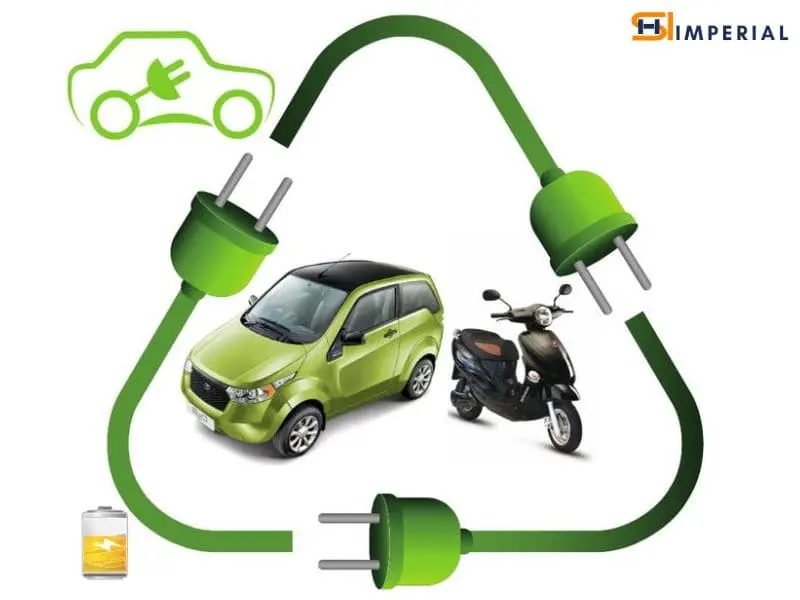Blog
The Future of Electric Vehicles: Are We Ready for the Shift”

Electric vehicles (EVs) are no longer a futuristic concept; they are rapidly becoming a reality in today’s automotive industry. With advancements in technology, increasing environmental awareness, and government policies encouraging the reduction of carbon emissions, EVs are poised to transform the transportation landscape. Major automakers are investing heavily in electric vehicle production, and more consumers are considering EVs as viable alternatives to traditional gasoline-powered cars.
The Future of Electric Vehicles: Are We Ready for the Shift”

The Growth of Electric Vehicles
The global electric vehicle market has seen remarkable growth in recent years. According to the International Energy Agency (IEA), the number of electric cars on the road reached 10 million in 2020, up from just 1 million in 2015. This exponential growth can be attributed to several factors:
- Technological Advancements: Improvements in battery technology have significantly increased the range of electric vehicles while reducing charging times. Modern EVs can now travel hundreds of miles on a single charge, addressing one of the primary concerns of early adopters—range anxiety.
- Environmental Awareness: As concerns about climate change intensify, more people are seeking eco-friendly alternatives to reduce their carbon footprints. Electric vehicles produce zero tailpipe emissions, making them a cleaner option compared to traditional internal combustion engine (ICE) vehicles.
- Government Incentives: Many governments around the world are offering financial incentives, such as tax credits and rebates, to encourage the adoption of electric vehicles. Additionally, some countries are implementing stricter emission regulations and setting ambitious goals to phase out the sale of gasoline and diesel vehicles within the next few decades.
- Automaker Commitments: Major car manufacturers, including Tesla, General Motors, Volkswagen, and Ford, have announced plans to increase their electric vehicle production and transition towards an all-electric future. These commitments are driving innovation in the industry and expanding the range of available EV models.
The Benefits of Electric Vehicles
Electric vehicles offer several advantages over traditional gasoline-powered cars, making them an attractive option for both consumers and policymakers:
- Reduced Emissions: EVs produce no tailpipe emissions, which means they contribute less to air pollution and greenhouse gas emissions. This is particularly important in urban areas, where vehicle emissions are a major source of air pollution.
- Lower Operating Costs: While the upfront cost of an electric vehicle can be higher than that of a gasoline-powered car, EVs are generally cheaper to operate. Electricity is typically less expensive than gasoline, and EVs have fewer moving parts, which means lower maintenance costs. Owners can save on fuel, oil changes, and other routine maintenance.
- Energy Efficiency: Electric vehicles are more energy-efficient than internal combustion engine vehicles. They convert a higher percentage of energy from the grid to power at the wheels, resulting in less wasted energy.
- Quiet and Smooth Ride: EVs offer a quieter and smoother driving experience due to the lack of engine noise and the instant torque provided by electric motors. This can make driving more enjoyable for many people.
- Energy Independence: Electric vehicles have the potential to reduce dependence on fossil fuels, particularly oil. As renewable energy sources like solar and wind power become more prevalent, the electricity used to charge EVs can be generated from cleaner, sustainable sources.
Challenges in the Transition to Electric Vehicles
Despite the numerous benefits, the transition to electric vehicles also presents several challenges that need to be addressed:
- Charging Infrastructure: One of the biggest hurdles to widespread EV adoption is the availability of charging infrastructure. While there has been progress in expanding charging networks, many regions still lack sufficient charging stations, particularly in rural areas. For EVs to become a mainstream choice, there needs to be a robust and accessible charging infrastructure that can support the growing number of electric vehicles on the road.
- Battery Technology and Range: Although battery technology has improved, range anxiety—fear of running out of charge before reaching a charging station—remains a concern for some potential EV buyers. Additionally, batteries are one of the most expensive components of an electric vehicle, and the cost of battery production, as well as concerns about the environmental impact of mining materials like lithium and cobalt, need to be addressed.
- Grid Capacity and Renewable Energy: As more electric vehicles hit the road, there will be increased demand for electricity. This raises concerns about whether the current power grid can handle the additional load, especially during peak charging times. To truly reap the environmental benefits of EVs, the electricity used to charge them should come from renewable sources. This means expanding renewable energy capacity and modernizing the grid to support the increased demand for clean energy.
- Affordability and Accessibility: While EV prices have been decreasing, they are still generally more expensive than traditional vehicles, especially when considering upfront costs. For widespread adoption, electric vehicles need to be affordable and accessible to a broader range of consumers. Governments and automakers must continue to work on reducing costs and providing incentives to make EVs a viable option for more people.
- Vehicle Lifespan and Recycling: Electric vehicles have different lifespans compared to traditional vehicles, primarily due to battery degradation over time. As EVs age, their batteries may lose capacity, reducing the vehicle’s range. Additionally, the disposal and recycling of EV batteries pose environmental challenges. Developing effective recycling methods and ensuring sustainable end-of-life management for EV batteries is crucial for minimizing their environmental impact.
Are We Ready for the Shift?
The transition to electric vehicles is well underway, but are we ready for the shift on a large scale? The answer is both yes and no.
Yes, we are making significant progress. The advancements in battery technology, the expansion of charging infrastructure, and the commitments from automakers and governments all indicate that the future of electric vehicles is bright. Public awareness of the environmental benefits of EVs is growing, and more consumers are willing to make the switch.
However, we are not fully ready yet. There are still challenges that need to be addressed, particularly in terms of infrastructure, affordability, and grid capacity. To ensure a successful transition to electric vehicles, continued investment in charging networks, renewable energy, and battery technology is essential. Collaboration between governments, businesses, and consumers will be key to overcoming these challenges and accelerating the shift to electric mobility.
The Future of Electric Vehicles: Are We Ready for the Shift”

Conclusion
The future of electric vehicles holds great promise for reducing carbon emissions, improving air quality, and creating a more sustainable transportation system. While there are challenges to overcome, the momentum behind electric vehicles is undeniable. With continued innovation and investment, we can pave the way for a cleaner, greener future where electric vehicles become the norm, and our transportation system is better aligned with our environmental goals. The shift to electric vehicles is happening—now it’s up to us to ensure that we are ready for it.
The Future of Electric Vehicles: Are We Ready for the Shift”
Blog
The Benefits of Yoga: More Than Just Flexibility

Yoga is often associated with impressive poses that showcase flexibility and balance. While the practice does enhance physical agility, yoga goes far beyond just improving flexibility. It has profound effects on mental health, emotional well-being, and overall physical fitness. Whether you’re a seasoned yogi or someone curious about starting, understanding the diverse benefits of yoga can inspire a deeper commitment to the practice.
The Benefits of Yoga: More Than Just Flexibility

1. Physical Strength and Stability
Though many think of yoga as a way to stretch and lengthen muscles, it’s equally effective in building strength. Certain yoga styles, such as Ashtanga, Vinyasa, and Power Yoga, involve holding poses that require significant muscular engagement. Even poses that seem simple at first glance, such as the plank or downward dog, can strengthen the core, arms, and legs when held for extended periods.
The practice of balancing on one foot or using your own body weight as resistance develops muscular stability. Over time, yoga improves posture, prevents injuries, and reduces the likelihood of conditions like osteoporosis by enhancing bone density. It’s a full-body workout that provides both strength and flexibility, leading to better physical resilience.
2. Stress Reduction and Emotional Well-being
One of the most well-known benefits of yoga is its ability to relieve stress. Life’s daily pressures can take a toll on mental and emotional well-being, leading to anxiety, restlessness, or even depression. Yoga incorporates mindfulness and controlled breathing techniques (pranayama), which help calm the mind and reduce the body’s stress response.
Studies have shown that regular yoga practice lowers cortisol levels—the hormone associated with stress. As you move through poses and concentrate on your breath, yoga helps you stay present, fostering a sense of inner peace and clarity. Many yoga practitioners report feeling lighter and more emotionally balanced after a session.
Furthermore, certain types of yoga, such as restorative or yin yoga, focus on slow, gentle movements, allowing the body to deeply relax and release tension. This not only soothes the nervous system but also promotes better sleep, which is essential for emotional resilience.
3. Enhanced Focus and Mental Clarity
Yoga isn’t just about training the body; it also sharpens the mind. The meditative aspect of yoga encourages you to focus on your breath and stay present. This mindfulness practice naturally spills over into daily life, improving concentration and cognitive function. Regular yoga practice has been shown to enhance memory, attention, and reaction times.
Additionally, yoga can help you break free from mental clutter. In a world filled with distractions, yoga gives you the opportunity to disconnect, quiet your thoughts, and bring your attention to the moment. This heightened awareness fosters mental clarity, enabling you to make more thoughtful decisions and respond to challenges with greater calmness and composure.
4. Better Breathing and Cardiovascular Health
Breathing is at the heart of yoga. Many yoga techniques emphasize deep, intentional breathing, which can improve lung capacity and efficiency. Practices like Ujjayi breathing (also called “victorious breath”) or alternate nostril breathing (Nadi Shodhana) help strengthen the respiratory system.
Improved breathing has numerous benefits for overall health. It can increase oxygen flow to the brain, reduce fatigue, and even regulate blood pressure. Over time, better breathing habits improve cardiovascular health, which in turn leads to increased endurance and energy levels.
For those with respiratory issues, yoga’s focus on breath control can help manage conditions like asthma or bronchitis by enhancing lung function and increasing awareness of how the breath moves through the body.
5. Improved Mental Health
The mental health benefits of yoga are significant. Studies have linked yoga with reduced symptoms of anxiety, depression, and post-traumatic stress disorder (PTSD). By encouraging mindfulness, emotional release, and body awareness, yoga offers a therapeutic pathway for individuals struggling with mental health challenges.
Yoga teaches us to approach our emotions without judgment, fostering self-acceptance and compassion. Whether you practice in a group setting or solo, yoga creates a safe space for emotional exploration and growth. Additionally, the release of endorphins during yoga can elevate mood and increase feelings of happiness and contentment.
6. Increased Body Awareness and Mind-Body Connection
Yoga encourages you to tune into your body’s sensations and movements. This heightened body awareness strengthens the connection between the mind and body, allowing you to notice subtle shifts in posture, breath, or energy levels. The ability to listen to your body’s signals can help you make healthier choices in your daily life, such as recognizing when to rest or when to push yourself.
The Benefits of Yoga: More Than Just Flexibility

This mind-body connection also supports better coordination and balance. Many yoga poses require precise alignment and movement, challenging both your physical and mental faculties. Over time, this improves overall coordination, making daily activities feel smoother and more effortless.
7. Boosted Immune System and Detoxification
Yoga also has a positive impact on the immune system. By reducing stress and inflammation, yoga strengthens the body’s natural defense mechanisms. Certain poses, particularly those that involve twists or inversions, stimulate the lymphatic system, which helps remove toxins from the body.
Additionally, yoga promotes better digestion and circulation, both of which contribute to a healthier immune response. A well-functioning immune system is essential for warding off illnesses and maintaining overall vitality.
8. Greater Flexibility: A Byproduct, Not the End Goal
It’s impossible to talk about yoga without mentioning flexibility, as this is one of the most apparent physical benefits. However, it’s important to view flexibility not as the primary goal of yoga, but as a beneficial byproduct. Increased flexibility can reduce the risk of injury, improve posture, and alleviate chronic pain—particularly in the lower back, shoulders, and neck.
Through regular practice, tight muscles gradually loosen, and joints become more mobile. This improved flexibility makes everyday movements easier and more comfortable. It’s worth noting that you don’t need to be flexible to start practicing yoga. Everyone’s body is different, and the beauty of yoga lies in its adaptability to suit any body type or skill level.
Conclusion: A Holistic Practice for All
Yoga is much more than a physical exercise routine. It’s a holistic practice that nurtures the body, mind, and spirit. From enhancing strength and flexibility to improving mental clarity and emotional well-being, yoga offers something for everyone. Whether your goal is to reduce stress, boost physical health, or find a deeper sense of inner peace, yoga provides the tools to lead a balanced and fulfilling life. So, the next time you roll out your yoga mat, remember that the benefits go far beyond just touching your toes.
Blog
How Blockchain is Transforming Industries Beyond Cryptocurrency

Blockchain technology burst onto the scene as the underlying architecture of cryptocurrencies like Bitcoin and Ethereum, enabling secure, decentralized, and transparent financial transactions. However, the application of blockchain technology has far transcended cryptocurrency, impacting a multitude of industries and revolutionizing how they manage and secure data. Blockchain’s potential for reshaping business processes, ensuring trust, and enabling new business models is transforming industries ranging from supply chain management to healthcare.
How Blockchain is Transforming Industries Beyond Cryptocurrency

1. Supply Chain Management
Blockchain’s ability to provide transparency, traceability, and security is making waves in supply chain management. Traditionally, supply chains are complex, involving multiple stakeholders like manufacturers, suppliers, logistics providers, and retailers. Each of these stakeholders maintains their own records, often leading to inefficiencies, errors, and even fraud.
Blockchain can streamline this process by creating an immutable and transparent ledger of every transaction along the supply chain. Each transaction or movement of goods is recorded on the blockchain, which all participants can access in real-time. This level of transparency helps in tracking products from origin to destination, ensuring authenticity, reducing fraud, and minimizing disputes. Major companies like IBM and Walmart have already implemented blockchain to improve food safety by tracking food products through every step of the supply chain, enabling them to trace contaminated products quickly.
2. Healthcare
In the healthcare industry, the importance of secure and accurate data management cannot be overstated. Patient records, clinical trials, and medical supply chains are all areas that can benefit from blockchain’s decentralized and tamper-proof system.
Blockchain can revolutionize electronic health records (EHRs) by ensuring that patient data is secure, easily accessible to authorized personnel, and immutable. Currently, healthcare providers often store patient data in isolated systems, leading to fragmented records and potential errors. With blockchain, patients can have a single, comprehensive medical record that they control, sharing access with healthcare providers as needed. This can improve the quality of care, reduce medical errors, and even streamline insurance claims.
Moreover, blockchain can enhance the integrity of clinical trials by ensuring that data collected during research is secure, unalterable, and timestamped. This reduces the risk of data tampering or manipulation, promoting greater trust in research outcomes.
3. Finance and Banking
While blockchain is synonymous with cryptocurrency, its impact on traditional banking and finance is equally profound. Financial institutions are adopting blockchain to increase efficiency, reduce costs, and improve security.
Blockchain-based solutions enable faster cross-border transactions by eliminating intermediaries and reducing the time taken to settle transactions. For example, traditional international money transfers can take several days to process due to the involvement of multiple intermediaries. With blockchain, these transactions can be settled in minutes, significantly reducing costs for both banks and customers.
Furthermore, blockchain can reduce fraud by providing a secure, transparent ledger for all transactions. Smart contracts—self-executing contracts with the terms directly written into code—are also gaining traction, automating various financial processes like loan disbursements, insurance claims, and trade settlements.
4. Real Estate
Real estate transactions are notorious for being time-consuming and paperwork-intensive. Blockchain can simplify and secure this process by digitizing property records and streamlining the transfer of ownership. Real estate transactions involve multiple parties—buyers, sellers, brokers, banks, and government agencies—and blockchain can facilitate a secure, transparent, and efficient process for all involved.
One of the key advantages of blockchain in real estate is the ability to create digital property titles, which are immutable and easily transferable. This reduces the need for physical paperwork, speeds up the closing process, and minimizes the risk of fraud. Additionally, blockchain can enable fractional ownership of real estate, allowing investors to buy and sell shares of a property, increasing accessibility to the real estate market.
5. Voting
Election security is a growing concern worldwide, with issues ranging from voter fraud to the integrity of the voting process. Blockchain offers a potential solution by providing a secure and transparent voting system. Blockchain-based voting systems can ensure that votes are recorded accurately and that the entire process is tamper-proof.
In a blockchain voting system, each vote is recorded as a transaction on a decentralized ledger, ensuring that no single entity can alter the results. Voters can verify their vote, and the entire process is transparent and accessible to authorized auditors. Governments and institutions are exploring blockchain voting solutions to enhance the trustworthiness of elections and increase voter participation.
6. Intellectual Property and Media
The media and entertainment industry is plagued by issues related to copyright infringement, piracy, and fair compensation for creators. Blockchain can offer a solution by providing a decentralized platform for managing intellectual property (IP) rights.
By recording ownership rights on the blockchain, creators can ensure that their work is protected and that they receive fair compensation whenever their content is used or distributed. Blockchain can also enable micropayments, allowing consumers to pay creators directly for content, bypassing intermediaries like streaming platforms or publishers. This can increase transparency in revenue sharing and ensure that artists and creators receive their rightful earnings.
7. Government Services
Blockchain is also being explored by governments to improve various public services. Blockchain’s ability to create secure, transparent, and tamper-proof records makes it ideal for managing identity, land registries, and public records.
For example, governments can use blockchain to create a secure digital identity for citizens, enabling efficient access to services like healthcare, social security, and voting. Blockchain can also streamline land registry systems, ensuring that property records are accurate and immutable, reducing the risk of disputes or fraud.
How Blockchain is Transforming Industries Beyond Cryptocurrency

Conclusion
Blockchain technology has evolved far beyond its initial association with cryptocurrencies, offering transformative solutions across a range of industries. Its ability to provide secure, transparent, and decentralized systems is being harnessed to improve efficiency, reduce fraud, and enable new business models. As blockchain continues to mature, we can expect even more innovative applications in areas as diverse as healthcare, finance, real estate, and government services. Blockchain’s potential is vast, and its impact on industries beyond cryptocurrency is just beginning to unfold.
How Blockchain is Transforming Industries Beyond Cryptocurrency
Blog
The Environmental Impact of Cryptocurrency: Is it Sustainable

Cryptocurrency has become a global phenomenon, transforming financial markets and sparking innovation across various sectors. But as digital currencies like Bitcoin, Ethereum, and others gain traction, a pressing question looms: What is the environmental impact of cryptocurrency, and is it sustainable in the long run?
The Environmental Impact of Cryptocurrency: Is it Sustainable

Cryptocurrency operates on decentralized blockchain technology, which provides security, transparency, and efficiency. However, the energy consumption associated with these digital transactions has led to significant environmental concerns. This blog will explore the environmental implications of cryptocurrency, the reasons behind its massive energy usage, and potential paths toward a more sustainable future.
The Energy Consumption of Cryptocurrency Mining
Cryptocurrency mining, particularly for Bitcoin, is a resource-intensive process. Mining involves solving complex mathematical problems to validate transactions and add them to the blockchain. This requires immense computational power, which, in turn, demands a substantial amount of electricity.
The energy consumption of Bitcoin mining alone rivals that of some countries. According to the University of Cambridge, Bitcoin consumes over 120 terawatt-hours (TWh) annually, more than entire nations like Argentina or the Netherlands. This energy usage is primarily driven by the “proof of work” (PoW) consensus mechanism, which requires miners to compete against each other to solve cryptographic puzzles. The more computational power a miner has, the better their chances of winning the reward.
While this ensures network security and decentralization, it also comes with a significant carbon footprint. Most mining operations are powered by electricity derived from fossil fuels, particularly coal and natural gas, which contribute to greenhouse gas emissions.
Carbon Footprint and Environmental Impact
The carbon footprint of cryptocurrency is a major concern for environmentalists. A study published in Nature Communications estimates that Bitcoin mining alone could push global warming above 2°C within the next three decades if the current trend continues. The reason behind this is twofold: the energy consumption involved in mining and the reliance on non-renewable energy sources.
China, which was once the world’s largest Bitcoin mining hub, heavily relied on coal-powered energy. Although the Chinese government has since cracked down on mining operations, many have relocated to countries with similar energy infrastructures. This means that the environmental impact continues unabated, with mining operations shifting rather than ceasing.
Moreover, the hardware used in mining, including specialized computers known as ASICs (Application-Specific Integrated Circuits), has a short lifespan due to rapid technological advancements. This leads to electronic waste (e-waste), which contributes to environmental degradation when not properly disposed of or recycled.
Efforts Toward Sustainability
Recognizing the environmental impact of cryptocurrency, industry players, governments, and environmental groups are seeking ways to make the sector more sustainable. Several strategies have emerged to address these concerns:
- Transitioning to Renewable Energy: One of the most straightforward ways to reduce the carbon footprint of cryptocurrency mining is to power operations with renewable energy sources. Some mining companies have already started moving their operations to regions where hydroelectric, wind, or solar energy is abundant and affordable. For instance, regions in Iceland and Canada, with their abundant geothermal and hydroelectric resources, have become attractive locations for greener mining operations.
- Proof of Stake (PoS) and Other Alternatives: The Proof of Work (PoW) consensus mechanism is the main driver of high energy consumption in cryptocurrency mining. Alternative mechanisms, such as Proof of Stake (PoS), have been developed to address this issue. In PoS, validators are chosen based on the number of coins they hold and are willing to “stake” as collateral, rather than competing in a computational race. This drastically reduces energy consumption. Ethereum, the second-largest cryptocurrency, has been working on transitioning from PoW to PoS through its Ethereum 2.0 upgrade. This move is expected to reduce its energy consumption by up to 99%. Other cryptocurrencies, such as Cardano and Tezos, have already implemented PoS, positioning themselves as more environmentally friendly alternatives.
- Carbon Offsetting: Another approach to mitigating the environmental impact is carbon offsetting. Some cryptocurrency projects are investing in carbon offset initiatives, such as reforestation projects or renewable energy credits, to balance out their emissions. Additionally, platforms like Moss and ClimateTrade have emerged, allowing crypto users to purchase carbon credits to offset their environmental impact.
- Innovative Protocols: Beyond PoS, other consensus mechanisms and protocols are being developed with sustainability in mind. For example, Proof of Space and Time (PoST), used by Chia Network, is designed to be more energy-efficient by using storage space rather than computational power. Similarly, other blockchain networks are experimenting with hybrid models that combine elements of PoW and PoS to achieve a balance between security and sustainability.
The Role of Regulation and Policy
Governments and regulatory bodies are beginning to take notice of the environmental impact of cryptocurrency. In some cases, they are introducing regulations to curb energy-intensive mining activities. For example, in New York, a bill was passed to impose a moratorium on certain crypto mining operations that rely on non-renewable energy sources.
At a global level, there is also growing pressure for more transparency in the cryptocurrency industry. Investors and consumers are increasingly demanding to know the carbon footprint of their digital assets, prompting some companies to disclose their energy usage and sustainability efforts.
The European Union, for instance, has proposed regulations that would require crypto companies to disclose their environmental impact as part of the broader push toward more sustainable finance. These policies could play a significant role in incentivizing the adoption of greener practices within the industry.
The Path Forward
The environmental impact of cryptocurrency is undeniable, but it is not insurmountable. The industry is still in its early stages, and there are ample opportunities to make it more sustainable. By transitioning to renewable energy, adopting alternative consensus mechanisms, and embracing carbon offsetting, the cryptocurrency sector can reduce its environmental footprint while continuing to innovate.
The Environmental Impact of Cryptocurrency: Is it Sustainable

Furthermore, collaboration between industry players, governments, and environmental organizations will be crucial in finding and implementing sustainable solutions. The future of cryptocurrency is closely tied to its ability to adapt to environmental challenges, and those who embrace sustainability will be better positioned for long-term success.
In conclusion, while the environmental impact of cryptocurrency is a significant concern, there are pathways to a more sustainable future. By focusing on green energy, innovative protocols, and responsible regulation, the industry can work toward a balance between financial innovation and environmental stewardship.
The Environmental Impact of Cryptocurrency: Is it Sustainable
-

 Politics6 months ago
Politics6 months agoNarendra Modi’s Heartfelt Connection with Kashi and Maa Ganga
-

 Travel6 months ago
Travel6 months ago6 Essential Travel Tips and Hacks for the Savvy Traveler
-

 Web Stories6 months ago
Web Stories6 months agoTips to Protect Your Smartphone from Getting Hacked
-

 Technology6 months ago
Technology6 months ago6 Essential Tips to Protect Your Smartphone from Getting Hacked
-

 Trending5 months ago
Trending5 months agoGoogle Gemini AI App Debuts in India: How It Operates on Android Devices – Comprehensive Guide
-

 Travel5 months ago
Travel5 months ago6 Budget Travel Without Visa from India: Top Destinations
-

 Travel5 months ago
Travel5 months ago6 Hill Stations in West Bengal That Are Perfect in July
-

 Fitness5 months ago
Fitness5 months ago5-Minute Workouts: Effective Home Exercises



